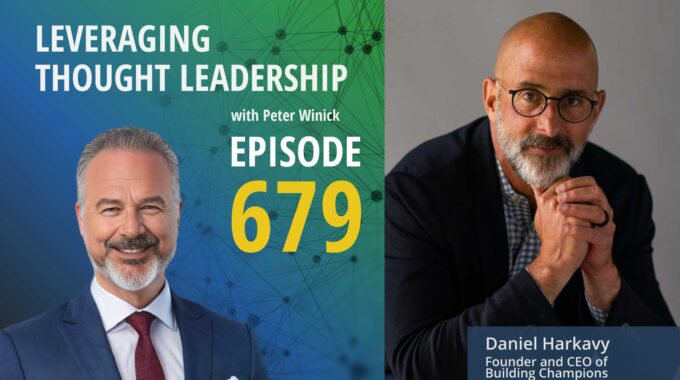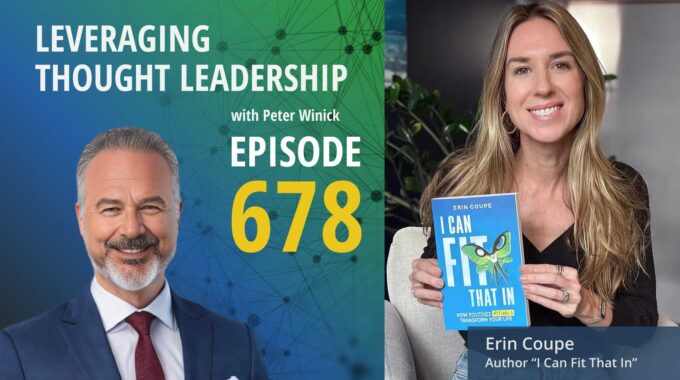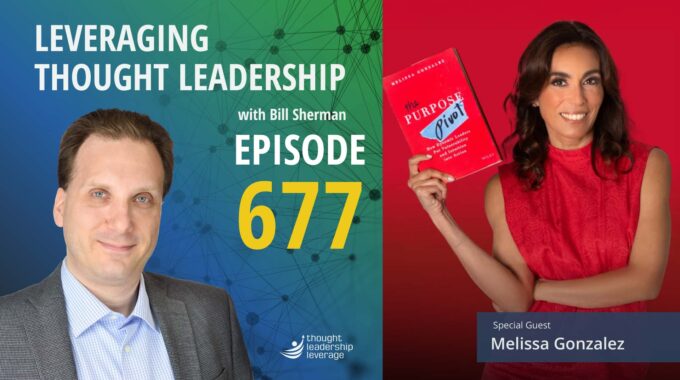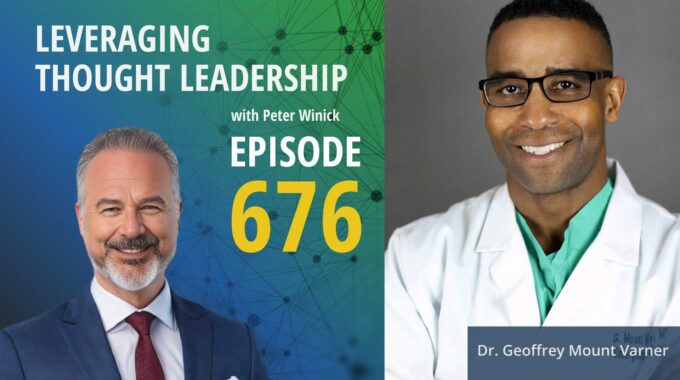A roadmap for leaders who want to multiply their impact — not their workload. This…
From Local Landmark to Global Platform: The Digital Evolution of the 92nd Street Y | Seth Pinsky
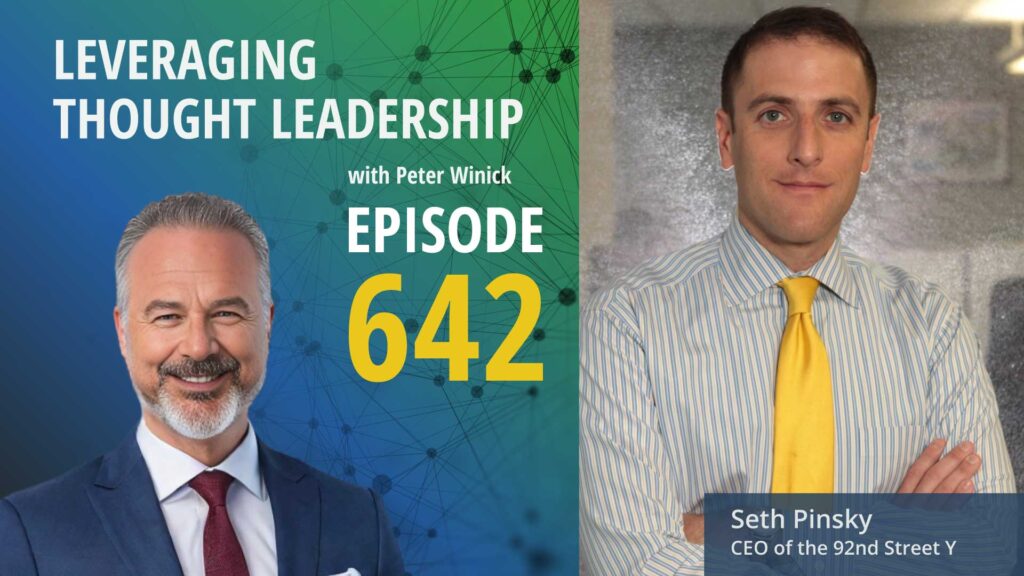
Turning Challenges into Global Opportunities
This episode explores how an iconic cultural institution successfully navigated the challenges of COVID-19 by rapidly transforming into a global digital platform. It highlights the strategic shift to online programming, unlocking significant international audience growth and new revenue opportunities. Additionally, it emphasizes the power of structured civic dialogue programs to foster meaningful, open-minded conversations in a polarized world.
Can a 150-year-old New York City institution thrive in the digital age?
Seth Pinsky, CEO of the iconic 92nd Street Y, joins us to reveal how they turned crisis into innovation. Founded to support immigrant communities, the Y evolved into a world-renowned cultural hub. Seth shares how, despite the initial shock of COVID-19 closures, the organization quickly pivoted, transforming itself into a global digital platform overnight.
Discover how they scaled online to reach millions—expanding their audience far beyond Manhattan. Seth explains key lessons learned, including tapping into an international market hungry for quality cultural content. By offering online programming, they attracted world-class talent and students from around the globe, dramatically increasing their impact and revenue streams.
We explore the Y’s innovative “Dialogue Project,” a fresh approach to civic discourse. In a polarized era, Seth discusses the project’s success in fostering respectful, mind-changing conversations. Audiences come away not just entertained, but transformed, underscoring the enduring power of meaningful dialogue.
Finally, Seth highlights the dual identity of the Y as both a prestigious cultural center and a vibrant community hub. He details strategic initiatives that integrate these aspects, creating unique experiences that foster deeper audience engagement. The 92nd Street Y’s reinvention shows that even historic institutions can harness change and become stronger than ever.
Join us and learn how flexibility, digital transformation, and courageous programming decisions can turn disruption into lasting opportunity.
Three Key Takeaways
Rapid digital transformation can dramatically expand audience reach and create new, sustainable revenue streams for traditionally location-based institutions.
Structured civic dialogue offers a powerful way to engage polarized audiences, encouraging openness and the potential to shift deeply held perspectives.
Organizations with dual identities—such as cultural and community centers—can leverage this unique positioning to create highly impactful and engaging experiences for diverse audiences.
If you found value in our discussion on the 92nd Street Y’s digital evolution and commitment to community engagement, you’ll appreciate episode 305, “Performance of Thought Leadership.” with Karen Leland. Discover how embracing a digital-first mindset can amplify your organization’s reach and impact in today’s rapidly changing landscape. Tune in to gain actionable insights that can help you navigate and lead in the digital era.
Transcript
Peter Winick And welcome, welcome, welcome. This is Peter Winick. I’m the founder and CEO at Thought Leadership Leverage. And you’re joining us on the podcast today, which is Leveraging Thought Leadership. Today, my guest is Seth Pinsky. He’s the CEO of the 92nd Street Y. He’s developed an action plan for the 92th Street Y to take it into its 150th anniversary. They’ve upgraded the building. He started his career as an attorney, but we won’t hold that against him. Uh, but I want to dive right in because for those of you, not from New York, You may or may not know what 92nd Street Y is and has been historically and culturally. So why don’t we start there, Seth, because I’m a New Yorker, so I love the Y. Long time listener, first time caller or whatever, but tell those unfortunate folks that have never been there what the Y is.
Seth Pinsky The 92nd Street Y was founded 150 years ago by a group of German Jewish civic leaders who saw large numbers of Eastern European Jews coming into the United States and decided that they needed to create a home to help those people assimilate into American life. Over time, it grew into something much bigger than that. And today, it continues to serve the Jewish community, but it really also serves the world well beyond that. Our programming ranges from arts and cultural programming to early childhood and family programming. We are a community center, so we also have a gym and a senior center and a residence. We do social impact and innovation programming. And, of course, continue to do programming for the Jewish community as well. We have about 3,500 people on an average weekday who come through our doors for our programming. And we, over the latest 12 months, had about 44 million people view our original content online from 200 countries around the world, all 50 states. So it really is a sprawling institution. But at its heart, everything that we do is about enriching lives and building community And we think that that’s a very important mission in a moment like this.
Peter Winick So it is really a platform. I mean, not to discount the early childhood and the gym and all that stuff, but from a thought, because those are important things, but from a thought leadership perspective, it’s one of those sort of places that everybody sort of makes the stop along the way. So I’ve seen everyone from Jeff Bezos there to Anderson Cooper and Gloria Vanderbilt and dozens of events. It’s become a place for thought leadership as well. Not just in the Jewish community, but it’s kind of a stop along the way on the New York tour, if you will. So talk about how the, how the vehicle had the platform has changed from come on a Tuesday night at eight o’clock and listen to, you know, Malcolm Gladwell talk about his book to, there was this little thing a few years ago called COVID, which probably wasn’t a good thing if you’re in an event based model business, but tell us how you sort of transformed the business during that time.
Seth Pinsky Sure. So I came to the 92nd Street Y in January of 2020. I remember going home one night in late January and saying to my wife, you know, it feels like this place kind of runs itself. I’m not exactly sure what my responsibilities are going to be. And then within a month, we were shutting the entire place down for the first time in its 146 year history. We made a decision very early on. That during COVID, our community would need the programming that we do more than maybe at any time in our history. And so we decided that we would keep our virtual doors open. And so all of our programming over the course of essentially a weekend, transitioned from in-person programming to online programming. But stay.
Peter Winick There a minute because 150 years, 92nd Street Y also comes because you’re on 92nd and Lexington, had you ever done digital remote, any of this stuff before and on a, on a scalable basis?
Seth Pinsky We had done it before and we were one of the early adopters among cultural institutions and community centers, but it really had not been done at significant scale. We were fortunate that we had experimented with it because it’s some of the infrastructure in place, but there was no plan, no interest in doing it at the scale that we ultimately had to roll it out. What was really interesting about the experience, and I think one of the things that benefited us as an institution as we made this transition, was because our programming is so sprawling, we essentially were running 30 or 35 experiments simultaneously, because each of our program areas had developed their own version of an online version of what they do. And what happened was that as we were learning lessons, it works in this area, it doesn’t work in that area. We were sharing it across the institution and it allowed us to improve on the model very quickly.
Peter Winick And it was a time where everybody’s trying everything. So what were some of the early learnings, right? Cause now, I mean, the upside of not being tied to the building is the world is your oyster, right. So what, what did you learn? Where did the audiences come from and what was the same and what was different?
Seth Pinsky Yeah, so one of the first and most interesting lessons that we learned was that there actually is an international audience for the programming that we create. And at a certain level, I think we had the conceit that that was the case, but we never really tested it. And what I remember was that right after we shut our doors, we were scheduled to the pianist Garrick Olson, who’s a very very well known pianist, appear on our stage. We had to cancel the concert. And he actually said, you know what, I’ll come in, I’ll play on the stage in front of an empty auditorium, and why don’t you broadcast it online? And at that time, our classical music programming was struggling to attract audiences, and often we’d be lucky to have three or 400 people come to a performance in our 900-person auditorium. We broadcast this concert, and I think the number was 125,000 views were recorded for the performance and they were from all over the world and that was really an aha moment for us. And what then happened as we weren’t even allowed to have people come into the building was that we found that not only were we able to attract an international audience, but we were able to attract talent to our programming weren’t in New York. So we have always had a very highly regarded adult education program, but it would be professors who happen to be in New York teaching students who happen to be a New York, we put that online and all of a sudden, not only did we find students from all over the world, but we were able to bring in Michelin starred chefs from Paris and heads of state from different countries and some of the leading educators from around the world to teach their courses. And this eventually evolved into an online platform that we call Roundtable. You can visit it at roundtable.org. And today we have thousands upon thousands of students taking our courses online, really, really sophisticated classes. So that was another lesson. And then the third thing that I would say, which was really important that we learned was when we started to put our programming online, and we realized. That our competition was no longer Lincoln Center or Carnegie Hall or local cultural institutions, our competition with YouTube. And on YouTube, you could basically find anyone in the world talking about any topic that you wanted. And it was very hard for us to compete with them until we had the insight that on YouTube when you watch a video, someone is talking to you. And what we were able to do through our programming was to have people speak with you. By adding that layer of community to the programming, it allowed us to distinguish ourselves from a YouTube video. And that was really the insight that I think launched the eventual success of everything that we did online.
Peter Winick Interesting. So now fast forward, the dust settles, the doors open, we take the masks off, blah, blah, I think early on with COVID, the, the mentality was, and this two shall pass, maybe it’ll be a weekend, a couple of weeks, a month, certainly by the spring, blah blah, but what are the permanent changes to the business now and how you approach attracting thought leaders as well as promoting publishing their thought leadership.
Seth Pinsky As I mentioned earlier, in passing, the digital programming has now become a permanent part of what we do. And there are a few reasons why we continue to do as much programming as we do online. One is that it allows us to attract people, both talent and thought leaders who aren’t in New York to participate in our programming, as well as audiences who aren’t in New York. But you know it also allows us to scale our programming in a way that we previously couldn’t. In the past, if an event sold out in our auditorium, that was it, we had our maximum audience. Now we can sell tickets online and it’s not uncommon for as many people to watch our programming online as are in the auditorium or in some cases have even more people do that. It’s also a not insignificant generator of revenue for us. So it’s allowed us to diversify our funding sources, which as I’m sure your listeners will understand for a not-for-profit is very important to create additional stability for the organization.
Peter Winick And if you’re enjoying this episode of Leveraging Thought Leadership, please make sure to subscribe if you’d like to help spread the word about our podcast. Please leave a five-star review at ratethispodcast.com forward slash LTL and share it with your friends. We’re available on Apple podcasts and on all major listening apps, as well as at thoughtleadershipleverage.com forward slash podcast.
Peter Winick So when you’re, I want to shift a little bit because I love the changes in what’s stuck and how it sort of transformed what you’re able to do and will be able to do for the foreseeable future. What is it that you look for when you are programming from a thought leadership perspective, right? There’s no shortage of business book authors, academics, thought leaders, former CEOs that would want to take the mic and take the stage at the 92nd Street Y. How do you make the decision over, well, we can only have three in October, and it’s going to be these three.
Seth Pinsky It’s not only three, we do about 300 events a year on our stages and many, many more classes and other programs. But you know, variety is very important for us. We want to have programming that’s purely entertaining. We want have programming, that’s going to make people think we want to add programming that’s gonna challenge people. We want app programming that beautiful and is going to convey a message and we try to balance all of those goals. Something that we’ve really been focusing on more lately is also the idea of promoting the concept of civic engagement and civic dialog. Again, as I’m sure your listeners will all understand, it increasingly feels as if that is a lost art in the United States that people not only are not able to engage with one another in a civil way. But people increasingly don’t even want to hear perspectives that are not consistent with the perspectives that they hold going into the conversation. We recently launched a program on our stages that we call the Dialog Project, where we are taking on pretty controversial topics. We’re bringing people from two sides of whatever the issue is. We have a very structured format with a highly regarded moderator. We have each of the participants speak at some length about their perspectives and engage with one another. And what’s been very interesting is, as part of this project, we’ve asked our audiences to vote on a question relating to the topic at the beginning of the conversation and then to vote again at the end. We’ve now completed our second of these programs and we’re about to roll out several more. But in both of the first two programs, the audience’s perspective actually shifted fairly dramatically by the end of the conversation, which to me really says that two things. One is that people are willing to listen and are much more open-minded than I think many of us give modern Americans credit for being. But second of all, also that when people hear a perspective that perhaps they haven’t heard before, they’re actually open to having their opinions change. And I think that’s an important lesson for all of us to learn. And it’s something that we hope to do more of and to make even more impactful going forward.
Peter Winick Well, yeah. Well, I think the variables are, you know, the format and the moderator as well, because I think it’s just become so, you know, everybody’s listening to their own, uh, wing tunnel or whatever.
Seth Pinsky Yeah, no, the phrase that we use is that people live on information islands.
Peter Winick Yeah, exactly. So it’s nice to go visit an island and listen, there’s something quaint about, you know, like having a conversation that’s respectful and civil and we can be on polar opposite ends of whatever that issue is for the most part, right? Like there’s some issues where there aren’t that, but I would imagine the things that you’re bringing to the stage and the folks that are coming there are open-minded enough to say, I didn’t come here tonight to have my mind changed. But I’m a fairly open-minded, curious, lifelong learning individual. If that happens to be an outcome, kinda cool. Interesting to see how the data plays out over time on that.
Seth Pinsky Yeah, no, we’re going to be, as I said, rolling out several more of these in the next few months, and we’re certainly going to continue to track whether the early trends continue going forward. But I think no matter what, just having people engaged in thoughtful conversation, and then having other people willing to listen to them is a really important accomplishment. Unfortunately, it’s something that we used to do all the time, but we don’t. And so, you know, it is an art form that we’re looking to revive.
Peter Winick I mean, I guess it could always end in like an MMA smackdown if we need to like lower the standards or something, right?
Peter Winick Right? Yeah, well.
Peter Winick Hoping to avoid that. Yeah, I hope so too. Any other thought? Cause you’re a little bit of a different guest and you’ve got this place, which is now a place plus an audience and you’re gone through this transformation. So anything else that you like, when you’re looking to make choices over, you know, curating again, an event on thought leadership, do you look at their followers, their ability to help you bring an audience to the marketplace? I understand the diversity and eclectic and variety and all that, but any other things that you look at and say, well, all things being equal, if somebody brought X to the table, that might be more helpful or put the thumb on the scale in their favor.
Seth Pinsky Yeah, I mean, certainly like any similar organization, we’re focusing on whether people have name recognition and, you know, we think about both how we will market a program and also whether those individuals themselves can market the program through online followers and social media presence and all of that. But you know one of the things that has always distinguish the ninety second street why is it’s a place. Brings people of very high quality to stages. We had a board meeting recently and our chair opened the meeting by saying that in the last, I forget, it was three or four days, the 92nd Street Y has hosted Martin Scorsese, Drew Barrymore, Steven Spielberg, Reed Hoffman, Hillary Clinton, and there were one or two other people on the list. You know what’s remarkable is that for a lot of organizations that would be an entire season and for us that was just the early part of a week but I think that our audiences to a certain extent trust our programmers who are really thoughtful about how they carry and i think earning and keeping that trust is a very important part of what has made the organization successful and that’s a focus on a lot.
Peter Winick I think that’s a really interesting point as it relates to the brand. That is the 92nd street. Like, you know, I can speak from experience that there are times where I’ve looked and like, oh yeah, you, I’m around on Wednesday. Let me go see, don’t really know who that person is. You know, you do the, but I’m like, I trust the 92 second street. Why is going to put something quality, interesting, you know, gravitas, whatever. So sure. Why not? Right. Like versus if it was a place I didn’t know that didn’t have the history that didn’t have the brand, so I like, I like that sort of. Both pieces of it, right? You’re not going to put. Junk on the stage, but like, you know, read, I mean, read Hoffman, Hillary Clinton, whatever it’s sort of like, Hey, hold my beer JCC. Oh, that’s pretty, and it’s true. It’s like, it’s amazing. What goes through the halls there, you know, you
Seth Pinsky Another thing that we’re really focusing on now is that what distinguishes us from many of our peers is that we are two different types of organization at once. We’re a world-class cultural center and we’re also a community center. There are very few places, I would argue maybe no places like us anywhere else in the world. But, at the same time, there are certain parts of our programming are much more under one umbrella or under the other rather than both. And something that we’ve been thinking about, especially since our experience of going online and learning about the importance of wrapping our programming in community, is that when you think about the programming that we have in our performance halls, a talk, a concert, a dance performance, a theatrical experience, the experience for many members of our audience is actually not all that different from the experience that they would have at a Lincoln Center or a Carnegie Hall. I mean, the content may be different, but you walk in, the lights go down, you watch something, you leave. And so something that we’re working on right now is to try to create a community wrap around that experience. So we’re doing two experiments right now. One actually on opposite ends of the age spectrum. One is. Called The Collective, which is a program for young professionals, I would say, recent college graduates, people in their 20s and 30s, where not only are we focusing on programming that will be interesting to that age cohort, but we’re creating social gatherings and other experiences around the programming so that it’s not just walking into a theater and leaving, but you’re building a community around the programing. Lastly, we have a program called Nexus that’s focusing on older individuals and doing similar types of programming experiences. And our hope is that if we can perfect the model with those two cohorts, we can do similar ideas with lots of different demographic groupings and really lean into what I think is one of our great competitive advantages, which is that we’re a dual institution rather than a single purpose institution.
Peter Winick That’s so true. Well, this has been fantastic. I appreciate your time today, Seth, and have always been and will continue to be a big fan of the 90 Seconds Review. So thanks. Thanks for sharing.
Seth Pinsky Thank you for having me and we look forward to hosting you and all of your listeners at the 92nd Street Y, either in person or online, 92ny.org, sometime soon.
Peter Winick To learn more about Thought Leadership Leverage, please visit our website at ThoughtLeadershipLeverage.com. To reach me directly, feel free to email me at peter at Thought Leadership leverage.com and please subscribe to Leveraging Thought Leadership on iTunes or your favorite podcast app to get your weekly episode automatically.


